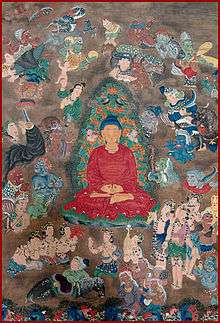Chöying Dorje, 10th Karmapa

| Part of a series on |
| Tibetan Buddhism |
|---|
 |
|
Practices and attainment |
|
History and overview |
|
Chöying Dorje (1604–1674) was the tenth Karmapa or head of the Kagyu school of Tibetan Buddhism.
Chöying Dorje was born in the kingdom of Golok, Amdo. At the age of eight, he was recognized by Shamar Mipan Chökyi Wangchuk, the sixth Shamarpa and received the complete Kagyu transmissions. He traveled extensively through Tibet.
During his life, Tibet faced inner instability as a pro-Kagyu king suppressed - against the will of the Karmapa - the Gelug school and forbade the search for the reincarnation of the Dalai Lama. The regent of the Gelug asked Güshi Khan, the warrior king of the Khoshut Mongols, for help.
The Mongolian army attacked Shigatse and forced many monasteries to convert to the Gelug school.[1][2] The civil war became such that Chöying Dorje had to flee Tibet and he appointed Goshir Gyaltsab as the temporary regent. The Kagyu school was almost completely annihilated in Tsang province, however, it remained in the provinces of Amdo and Kham.
During his exile, Chöying Dorje travelled extensively through Bhutan, Amdo and Kham in East Tibet, Burma and Nepal, founding many monasteries in the process. He returned to Tibet twenty years later, however the Kagyu school was, by then, no longer the dominant school of Tibetan Buddhism.
In 1674 the 5th Dalai Lama met with Chöying Dorje at the Potala Palace, and the reconciliation was welcomed by all after the many conflicts and difficulties.[3]

Art
Within the Tibetan artistic heritage, Chöying Dorje is perhaps the most exceptional artist of all times. The various biographies agree that the 10th Karmapa was a talented painter and sculptor already at a young age. It is also repeatedly stated that he was from a young age especially fond of Indian statues from Kashmir. This explains why many of the statues made by the Tenth Karmapa – regardless whether cast in metal or carved in ivory, wood, or conch shell, etc. – are stylistically very close to brass statues from Kashmir and Swat.
However, Chöying Dorje was not simply copying ancient Indian and Tibetan works. Just inspired, he rather created his own work of art – albeit using ancient stylistic elements. As mentioned in his biographies, he had ample opportunity to study early statues during his recurring visits to the Jokhang temple in Lhasa. His activities as a painter were evidently influenced by the Chinese tradition, which also explains why Chöying Dorje painted many works on silk. Chinese influence in the works of Chöying Dorje has its origin in arhat paintings that he had seen in Tibet and copied several times. The Tenth Karmapa also encountered other Chinese silk paintings during his exile in Lijiang, where he stayed for several years at the court of the local ruler. Chöying Dorje also created paintings influenced by Kashmir and Western Tibetan styles.[4][5]
References
| Wikimedia Commons has media related to Chöying Dorje, 10th Karmapa. |
- ↑ Laird, Thomas. (2006). The Story of Tibet: Conversations with the Dalai Lama, p. 165. Grove Press, New York. ISBN 978-0-8021-1827-1.
- ↑ Richardson, Hugh E. (1984). Tibet and its History. Second Edition, Revised and Updated, p. 42. Shambhala. Boston & London. ISBN 0-87773-376-7.(pbk)
- ↑ Karmay, Samten C. (2005). "The Great Fifth", p. 2. Downloaded as a pdf file on 16 December 2007 from:
- ↑ von Schroeder, Ulrich. Buddhist Sculptures in Tibet. Vol. One: India & Nepal; Vol. Two: Tibet & China; pp. 96, 530, 702, 706, 744 nn. 619–620; 745, 747, 752, 754, 756, 762, 764, 796–819, 997, 1126, 1223, 1230; Figs. XII–18–25; Pls. 16D–E (?), 191–194, 340B (?). (Hong Kong: Visual Dharma Publications, Ltd, 2001.) ISBN 962-7049-07-7; ISBN 978-962-7049-07-4.
- ↑ von Schroeder, Ulrich. Buddhist Sculptures of the Alain Bordier Foundation. pp. 50–51, pl. 22A. (Hong Kong: Visual Dharma Publications, Ltd., for the Alain Bordier Foundation, 2010) ISBN 962-7049-14-X; ISBN 978-962-7049-14-2
External links
- The History of the Kagyu Lineage - from the Kagyu Office Website
- The 10th Karmapa - from the Karmapa Website
Further reading
- Thinley, Karma (2008). The History of Sixteen Karmapas of Tibet. USA: Prajna Press. p. 150. ISBN 1-57062-644-8.
| Preceded by Wangchuk Dorje |
Reincarnation of the Karmapa | Succeeded by Yeshe Dorje |